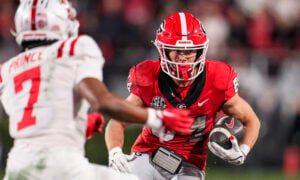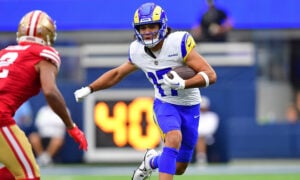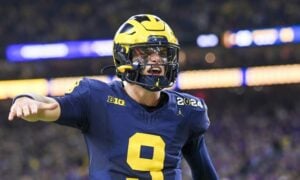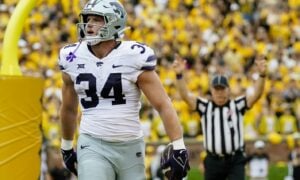IDP Rookie Safety Archetypes
I’ll tell anyone who will listen how much I love NFL safety play. They’re flexible, variable, exciting, and impactful. They have to master multiple skills like no other players in the NFL.
But the simple term “safety” is very misleading. Given how flexibly they’re used, it’s hugely important to understand how different players are used and therefore how valuable they’ll be as IDPs.
It’s never too early to start analyzing how useful they’ll be so I wanted to start splitting some of my favorite players in the class into groups and trying to identify potential landing spots.
What roles exist in the NFL?
Deep safeties
In a league with a lot of teams who predominantly run a cover one/three scheme this is the free deep safety. He’s the player furthest away from the ball and needs to display range, decision-making, timing, and intelligence. Think Earl Thomas, Glover Quin, Malik Hooker or Kevin Byard. Going back a little further, Ed Reed is the true template for the position.
Most of the best-paid safeties in the NFL are deep safeties which tells us how highly the league values this skillset. There just aren’t a lot of prospects who display the elite speed and instincts the position needs.
Unfortunately, the IDP world tends not to value these players that much which means we often fall into the trap of not really understanding how important they are to real defenses.
[am4show have=’g1;’ guest_error=’sub_message’ user_error=’sub_message’ ]
Box safeties
These are the flipside of deep safeties – the bigger boys who lurk closer to the line of scrimmage. They need the size and physicality to stand up in the running game but also the athleticism to play in the coverage game and even in the slot.
Keanu Neal, Jahleel Addae, Kam Chancellor and Johnathan Cyprien are all current examples. Adrian Wilson is my favorite historical example.
This is often seen as the most valuable spot by IDP fans because they tend to score the most points given their tackle opportunities. But in reality, this is a much less scarce resource. Because so many college schemes are built on spread and option principles, the natural response is players like this. Athletic, physical, mobile.
Two-deep safeties
Even two-deep is a bit of a misnomer. Flexible or interchangeable might be better words. The point is here is that if NFL offenses are built on mismatches then NFL defenses have to be built on avoiding mismatches. Therefore, it needs players who can play many different roles without being exposed.
Jamal Adams, Patrick Chung, Shawn Williams and Tony Jefferson are players who fit into this bucket for me. They’re often seen as better NFL options than IDP ones.
You see many players here who are used as a jack-of-all-trades. They might be in the box one play, lining up deep on the next, in the slot the next and rushing the passer on the next. They tend to have much more rounded skillsets but are less proficient in any one skill than any of the specialist roles. This is a microcosm of the game. The art of coaching is to figure out what a player can do well and out him in a position to do it.
Prospects
This is my current estimate on how these players might be used in the NFL. A lot depends on their landing spot so we’ll have a better idea in a few weeks.
Derwin James, Florida State
James’s all-around skillset is fantastic which befits a player lauded as a top-ten talent in this draft. The one trump card he has over most of his rivals is his ability to rush the passer. I suspect he’ll spend time in the box, covering tight ends and bigger slot receivers and blitzing.
DeShon Eliot, Texas
Eliot lined up predominantly deep in Texas. He’s 6’2” and 210 pounds so I think people will assume he’s more of a box player. However, surprisingly he reminds me of former teammate, running back D’Onta Foreman – in that he’s a finesse player in a big body. His best ability as a defender is being able to get his hands on balls in coverage.
At the moment, I’m ranking him fairly low in IDP terms because of this. He doesn’t have the range to play true free safety in the NFL and he certainly doesn’t have the physicality to play strong.
Damon Webb, Ohio State
I think he’s the closest thing there is in the draft to the cover one deep archetype. He certainly filled that role at OSU coming in in 2017 to take Malik Hooker’s job.
His relatively slow 40 time and lack of other measurables is a huge red flag for me and I suspect he’ll drop in the NFL draft. He won’t be on any of my IDP rosters.
Terrell Edmunds, Virginia Tech
I love Edmunds. He’s a top five safety for me in this draft. I love his combination of range and physicality. He’s 6’2”, 200 lbs and ran a 4.47 40 time. And he’s nowhere near as athletic as his brother Tremaine!
He’s very close to the increasingly frayed line between linebacker and strong safety and could easily be a cheat code in IDP terms. If he’s drafted before the fifth round I’ll be very, very interested.
Quin Blanding, Virginia.
Blanding is very talented and has the ability to play in the box. However, he’s also a very talented player in coverage and I think he’ll land with a team willing to use him flexibly. He’s likely to go earlier than many people expect, and landing spot will be hugely important.
Justin Reid, Stanford
I think Reid is going to play a lot in the slot in the NFL. He can do a bit of everything, but he has no real trump card bar his athleticism. Watch for him to move around the formation a lot a la Patrick Chung. There’s noise about him being taken in the top round which will make him a lot more attractive to me.
Jessie Bates, Wake Forest
Bates is a player with high highs and low lows. He’s shown the ability to perform fantastically in coverage as well as lay down big hits in the running game. But he also missed 16 tackles in 2017 alone. That’s far too many.
I see him a third safety on a team who can move around and be used as a matchup weapon.
Kyle Queiro, Northwestern.
He’s a classic strong safety. Queiro has the size (6’3”, 220) and attitude to play in the box. He has 100 solo tackles combined in his last two college seasons.
I see him as exclusively a strong safety at the next level but likely not good enough to land in an immediate starting spot. He’ll be a stash on deep rosters.
Ronnie Harrison, Alabama
Harrison played deep on a fair amount of snaps at Alabama given the flexibility of their secondary but it seems to me that his best spot is in the box and I suspect he’ll be taken as one.
I can’t wait to see how early he’s selected. If he goes in the first two or three rounds he’ll become a hot IDP name.
Marcus Allen, Penn State
Allen is a clear strong safety. He’s consistently produced well statistically with 197 solo tackles in the last three seasons. He’s limited in coverage and certainly not the best talent on the board, but he can fit the classic box safety mold extremely well.
Natrell Jamerson, Wisconsin
Jamerson is my draft crush. Jamerson is this year’s answer to Budda Baker and Tyrann Mathieu. He’s a hybrid of a slot corner and a free safety with extreme aggression and the desire to hit much harder than his slight frame suggests. I suspect he’ll be a full-time slot player at the next level but he’s definitely one to watch.
Steven Parker, Oklahoma
Parker is a classic two-deep safety. He can happily rotate box and deep duties, slide over to give corners help over the top and play cover-two all day long. But I don’t see him as an exciting prospect in IDP simply because he lacks a true trump card.
Summary
It’s important to know that not all teams use all of these archetypes – either at all or in the same combination. The days of each team having a box and a deep safety are long gone and it’s often much more complicated than that. Especially on teams like the Saints, Patriots, Chiefs or Broncos that play a lot of big nickel looks with three safeties on the field.
Final landing spot will tell us a lot but for now, it’s just good to know who is likely to end up in which group.
Thanks for reading.
[/am4show]
- Ten IDP Fantasy Football Stats You Need to Know after Week 16 - December 29, 2023
- Ten IDP Fantasy Football Stats You Need to Know after Week 15 - December 22, 2023
- Ten IDP Fantasy Football Stats You Need to Know after Week 14 - December 14, 2023


































































